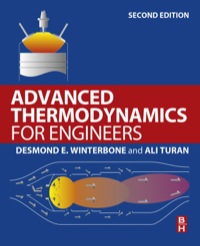Distinguish between an ideal and a perfect gas and show that in both cases the specific entropy,
Question:
Distinguish between an ideal and a perfect gas and show that in both cases the specific entropy, \(s\), is given by
\[s=s_{0}+\int_{T_{0}}^{T} \frac{\mathrm{d} h}{T}-\Re \ln \left(\frac{p}{p_{0}}\right)\]
Two streams of perfect gases, A and B, mix adiabatically at constant pressure and without chemical change to form a third stream. The molar specific heat at constant pressure \(c_{p, m}\) of the gas in stream A is equal to that in stream B. Stream A flows at \(M \mathrm{kmol} / \mathrm{s}\) and is at a temperature \(T_{1}\), while stream B flows at \(1 \mathrm{kmol} / \mathrm{s}\) and is at temperature \(n T_{1}\). Assuming that the gases A and B are different, show that the rate of entropy increase is
\[c_{p} \ln \left[\frac{1}{n}\left(\frac{M+n}{M+1}\right)^{M+1}\right]-\Re \ln \left[\frac{1}{M}\left(\frac{M}{M+1}\right)^{M+1}\right]\]
How is the above expression modified if the gases A and B are the same?
For the case \(n=1\), evaluate the rate of entropy increase
(a) when different gases mix, and
(b) when the gas in each stream is the same.
\(\left[c_{p, m} \ln \left\{\frac{1}{n}\left[\frac{M+n}{M+1}\right]^{M+1}\right\} ; \quad-\Re \ln \left\{\frac{1}{M}\left[\frac{M}{M+1}\right]^{M+1}\right\}\right]\)
Step by Step Answer:

Advanced Thermodynamics For Engineers
ISBN: 9780080999838
2nd Edition
Authors: D. E. Winterbone, Ali Turan





